 Open Access
Open Access
ARTICLE
Efficient Energy and Delay Reduction Model for Wireless Sensor Networks
1 Institute of Southern Punjab, Multan, 60000, Pakistan
2 College of Computer Science and Information Systems, Najran University, Najran, 61441, Saudi Arabia
3 Department of Computer Skills, Deanship of Preparatory Year, Najran University, Najran, 61441, Saudi Arabia
* Corresponding Author: Ansar Munir. Email:
Computer Systems Science and Engineering 2023, 46(1), 1153-1168. https://doi.org/10.32604/csse.2023.030802
Received 02 April 2022; Accepted 24 June 2022; Issue published 20 January 2023
Abstract
In every network, delay and energy are crucial for communication and network life. In wireless sensor networks, many tiny nodes create networks with high energy consumption and compute routes for better communication. Wireless Sensor Networks (WSN) is a very complex scenario to compute minimal delay with data aggregation and energy efficiency. In this research, we compute minimal delay and energy efficiency for improving the quality of service of any WSN. The proposed work is based on energy and distance parameters as taken dependent variables with data aggregation. Data aggregation performs on different models, namely Hybrid-Low Energy Adaptive Clustering Hierarchy (H-LEACH), Low Energy Adaptive Clustering Hierarchy (LEACH), and Multi-Aggregator-based Multi-Cast (MAMC). The main contribution of this research is to a reduction in delay and optimized energy solution, a novel hybrid model design in this research that ensures the quality of service in WSN. This model includes a whale optimization technique that involves heterogeneous functions and performs optimization to reach optimized results. For cluster head selection, Stable Election Protocol (SEP) protocol is used and Power-Efficient Gathering in Sensor Information Systems (PEGASIS) is used for driven-path in routing. Simulation results evaluate that H-LEACH provides minimal delay and energy consumption by sensor nodes. In the comparison of existing theories and our proposed method, H-LEACH is providing energy and delay reduction and improvement in quality of service. MATLAB 2019 is used for simulation work.Keywords
The latest advancements in the network world, being self-configured and having minor infrastructure network architecture are always top priorities. Wireless sensor networks have these features and consist of diverse sensor nodes distributed and particular base stations. These sensor nodes can measure environmental circumstances like pollution levels, temperature, humidity, etc. nodes are deployed in monitoring areas in a distributed manner. In the last few years, most of the research has been done in the wireless sensor domain and is still a hot topic in research areas like energy consumption, delay, security, data aggregation, and Quality of Service (QoS) in WSNs. But there are still many challenges in this domain. Sensor nodes have low consumption capacity and are not energy efficient with several security threats. Data aggregation is a complex scenario in WSNs [1]. Unlike other networks, WSNs protocols mechanism complications are increasing due to the impossibility of human activities because of the uncertain deployment area of the sensor node. Enormous research has been done on QoS, but the important thing is that these QoS aren’t guaranteed. Due to the outage of the energy consumption in sensor nodes, there is a big issue with maintaining QoS in WSN. Only limited work has been done to support QoS and security with data aggregation. The author has attempted to overcome the issue of QoS and security simultaneously, but it does not take average transmission time into account. There is another link and data aggregation issue to maintain QoS for efficient energy. The authors proposed a fuzzy logic technique in which data aggregation of different domains is automatically reported by sensors [2]. But still, there is a need to propose an improved model which maintains security as well as efficient energy in terms of quality of service with minimum delay transmission. Our primary focus is to present a novel, improved model with reliable efficiency to enhance the life of wireless sensor nodes and their consumption by using LEACH and other protocols.
LEACH protocol is used for energy efficiency. The main purpose of LEACH is to provide energy efficiency and maintain the cluster in the network. LEACH is a protocol that extends the lifetime of wireless sensor networks. Sensors form a cluster in the LEACH protocol, and a single node of these nodes serves as the cluster head.
H-LEACH is the advanced version of the LEACH protocol which is used in heterogeneous wireless networks. It is another LEACH-based protocol which is used two levels of hierarchies [3].
SEP is a two-level heterogeneous protocol that uses two types of nodes: normal and advanced. Normal nodes have less energy than advanced nodes. Both normal and advanced nodes have a weighted likelihood of becoming cluster heads in SEP [4].
One hierarchical routing protocol is PEGASIS, which uses a chain-based method with a greedy algorithm. The sensor nodes create a chain as a result of their self-organization. If any node in the chain dies in the middle, the chain is recreated to avoid the dead node [5].
MAMC is a data aggregation approach that is used to reach the best efficiency and data delivery trustworthiness [6].
1.6 Whale Optimization Algorithm
The Whale Optimization Algorithm (WOA) is a novel approach to tackling optimization issues. This program incorporates three operators to replicate the hunt for prey, surrounding prey, and bubble-net foraging behavior of humpback whales. It is a recently developed swarm-based meta-heuristic method for addressing complicated optimization problems based on humpback whales’ bubble-net hunting move strategy [7].
We have used Whale Optimization Algorithm the increase network Lifetime. It will be improved when WOA is applied on Hetero-LEACH. Nodes will be deployed on the shorter path to sense the information and transmit it; if the cluster is in a distant location, the power will be lost, so the network lifetime will be reduced. So WOA has increased the lifetime of the network.
Computational complexity has been reduced by WOA, due to which delay has also been reduced. Deceptive energy has increased when the nodes are at a distant position. Due to transmission, the nodes will lose energy, but in this case, all nodes have gained the specific energy, which will be beneficial for enhancing the network life. Transmission at the correct time, throughout, a number of active nodes, and several inactive nodes factors significantly impact QoS.
It is very important to calculate deceptive energy and data transmission rate in WSNs because it is widely used in every field of life, especially when the authors of this paper are discussing medical, military, and navigation systems. After identifying the main issues, this research will focus on energy efficiency and delay reduction. But other factors like security and average transmission time are not fully focused on.
Our proposed model H-LEACH with WOA, has novelty in nature to enhance and optimize the quality of service parameters in terms of data aggregation in WSNs. It is used to provide energy and delay reduction parameters with the collaboration of WOA to optimize our results. This work contributes to developing a method for building a network structure with the least data aggregation delay.
The rest of the paper is structured as follows. Sections present the related work and a detailed overview of the previous studies. Section 3 explores the methodology and the implementation of the models. Section 4 depicts experimental results. Finally, Section 5 illustrates the conclusions and identifies the future directions.
The major goal of the Effective Hybrid Routing Protocol (EHRP) is to merge single-hop and multi-hop routing. The simulation findings reveal that EHRP can reduce energy usage and delay while improving performance compared to its competitors [8]. Improves the author also adopted LEACH to improve energy efficiency. LEACH is based on selecting the best cluster head near the sink for data gathering and with maximum energy. With this enhanced LEACH author gets better results than the traditional LEACH protocol. The simulation is performed in MATLAB [9]. In WSN, QoS is the crucial parameter for analyzing the efficiency of the network. The authors presented a QoS-based energy-efficient protocol to prolong the lifetime of the set-up and reduce consumption. MATLAB is used to analyze the model [10]. The author suggested the enhanced WOA, which improves accuracy, dependability, and fast convergence. This method produces superior results in keeping a good balance between diversification and intensification inclinations [11]. In WSN, using graph theory, find the shortest distance using modules of Shortest Route Evaluation (SRE), distance evaluation, and shortest route evaluation. Our simulation result shows that it minimizes the energy to increase the lifetime of the wireless sensor network [12]. In this paper, the author highlighted the issue of the selection of clusters in WSN. The proposed model comprises three steps, one of them being set up level, measurement level, and transmission phase. The first step is initialized energy and node mobility and then select CH using the Root Shoot Coordination Optimization (RSCO) algorithm. The result shows better performance in the way of energy efficiency with the value of nodes 0.0351 J, 74.715%. In this paper, the author proposed K-means and K-medoids to solve this energy issue in a cluster or without cluster infrastructure. With the help of data, the aggregation author achieved better results using the MATLAB simulator [13]. Energy depletion is one of the main issues in WSN. The author proposed crossed layer methodology for a better energy-efficient “Position Response routing protocol” (PRRP). This protocol reduces the idle state time and distance for communication in the network. As a result of this significance, efficiency increased in WSN [14].
Data aggregation is the primary concern in enhancing the lifetime of sensor nodes and reducing the transmission delay. Some parameters are because to delay of aggregation and affect the overall quality of the network. The authors presented a Dynamic Difference Attenuation Recognition (DDAR) scheme to reduce the above factor and enhance the QoS of the WSN transmission. This scheme helped reduce the delay by approximately 25% and 55% improvement in the life of nodes [15]. The author has applied the energy-Efficient Routing Mechanism (EERM) to overcome energy issues in WSN. The key purpose of this procedure was to gather facts from the area of importance and send them to the sink by the nearest node. EERM showed better results which enhanced the network’s life [16].
Another work has been done using the Fuzzy Attribute-Based Joint Integrated Scheduling and Tree Formation (FAJIT) technique, which focuses on finding primary node selection with a minimum number of adjacent nodes. The aggregation author achieved a better result by using fuzzy logic with data. The proposed Auto-Regressive Integrated Moving Average (ARIMA) model protects the data aggregate using the Hadoop Wireless Sensor Network Framework (HWSNF). It also maintains data privacy, and the time series analysis approach protects adversary data. Our system provides data storage predication in the sensor node and data updating. The experimental result shows that our proposed method shows high accuracy, communication, and computation cost and achieves the best security. This work does not care about data integrity which we will further study in the future [17]. The proposed data aggregation model in WSN uses a fire-fly algorithm, where we use the cluster for the active and inactive nodes. In the active node, we identify the Area size, energy, and distance, and our proposed method protects the data from duplication and network and does not impose extra overhead. Our simulation result shows that our method is more efficient than the previous method, where we enhance the QoS using a shuffled frog algorithm and low-energy adaptive clustering hierarchy [18]. With data aggregation, there is a need to enhance energy efficiency with the lifespan of sensor nodes; the authors proposed the LEACH technique to overcome energy resource limitations. In this paper, the authors proposed LEACH with a generic algorithm that is optimized. Simulated MATLAB results show a reduced 17.39% energy consumption rate. Another research proves that LEACH provides good quality of services in terms of energy consumption. LEACH routing protocol always selects the best cluster-heads with the maximum required energy and minimal distance via sink nodes. The simulation is performed on MATLAB, showing better results than conventional protocols [12].
WSNs comprise many Sensor Nodes (SN) positioned in a certain area and used for a specified purpose. WSNs are an extensive range of networks that can be utilized in various fields such as environmental monitoring, security applications, hospitals, and monitoring. These nodes, often modest in size, can be processed, communicated, and sensed. Sensor nodes transmit through short-distance radio signals and operate together to perform duties. On the other side, SN has a limited quantity of bandwidth, energy, memory, computer resources, and longevity. The main job of an SN is to identify and report target occurrences like heat, light, and temperature to the host controller or sink via a query answer. For calculation, WSNs consume less energy than data transportation. Instead of individually transmitting each item of sensed data to the sink node, it is possible to collect and aggregate data using aggregate methods such as sum (), average (), and so on.
The process by which meaningful information can be collected and aggregated in a particular area of interest in WSNs is known as data aggregation. Using the data aggregation approach determines the effectiveness of communication between nodes. Data aggregation has been seen as an essential processing activity to save valuable resources and minimize energy use [19].
The most critical limitations in sensor networks are the data aggregation latency and the network’s longevity. These two restrictions could not be optimized simultaneously, as previously stated. We aim to preserve normal network life while minimizing the latency of data aggregation. The strategy could be useful when time is essential. By creating a delay-efficient network topology, we could obtain the lowest achievable latency in our method. Transmission distances of the sensor nodes are maintained to a minimum, saving energy for the network.
In summary, this paper makes the following contributions:
• Providing a technique for constructing a network structure with the shortest data aggregation delay.
• Comparing previous different algorithms of H-LEACH, LEACH, and some other previous techniques.
• Providing a distributed solution with the help of the WOA that scales effectively as the network grows larger.
Wireless sensors are spread over the network and form a network. After deployment, the SN and Base Stations (BS) placements are not modified. It is considered that the energy depletion of nodes is linked to the square of their communication distance. We have used five aggregation models to calculate reduction and delay, after finding out the best algorithm, we have applied WOA for more efficiency. The proposed model is described in Fig. 1.
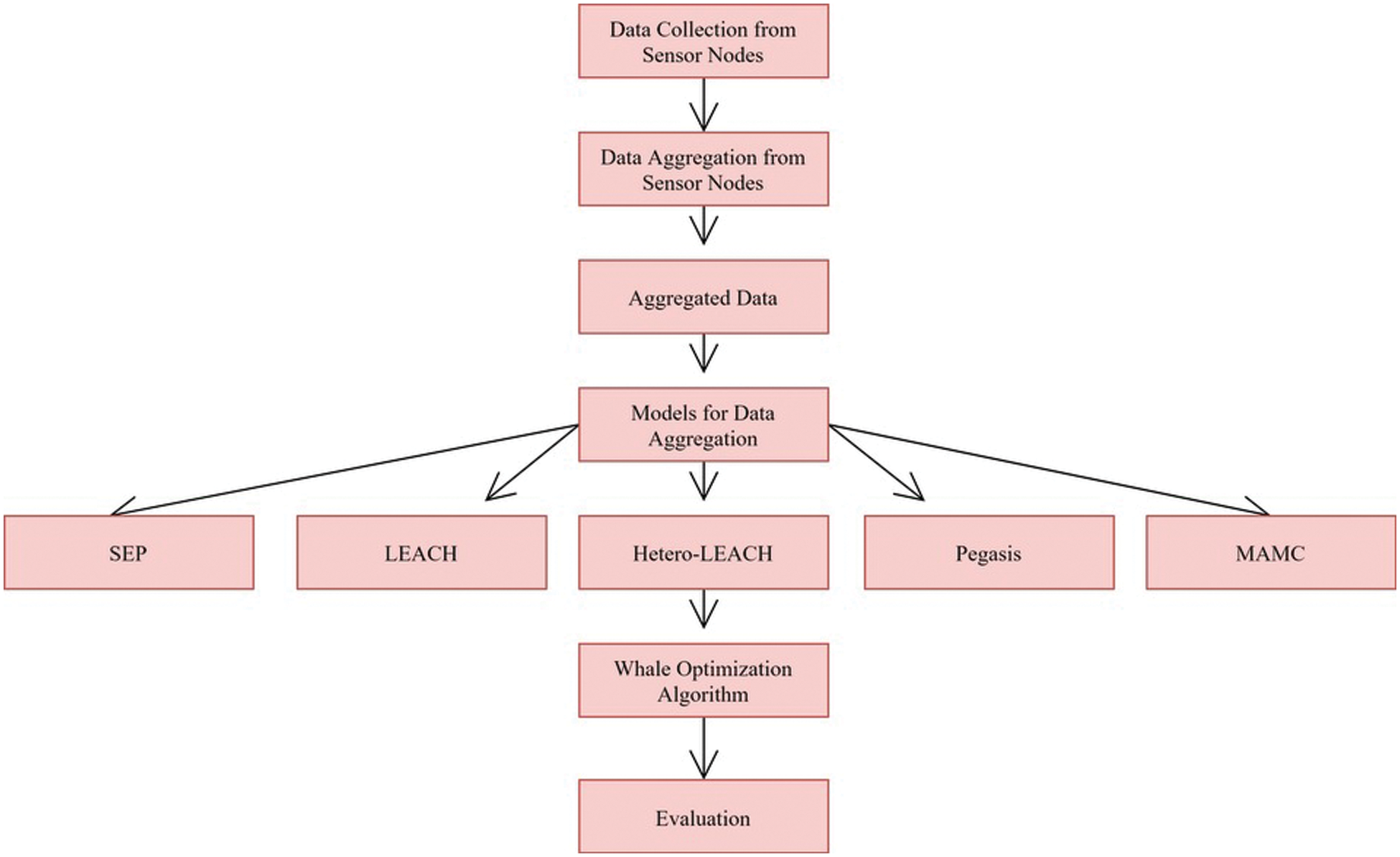
Figure 1: Proposed model
Fig. 1 illustrates the proposed model of our study. In step 1, we collect data from different nodes in a network. These nodes are adjacent. In step 2, we perform data aggregation, and aggregated data is sent to evaluate different protocols. In the next step, the Whale optimization algorithm is applied and evaluates the best result.
3.4 Theoretical Presentation of Data Aggregation
We anticipate sensors can optimize their transmitting ranges to access more nodes and the BS directly. After passing through aggregation channels, information from the sensor nodes is collected in the sink. Data fusion is expected to be perfect, meaning all packets’ sizes are the same. A slot is considered to transfer data from a node to its parent. As every sensor has just one transmitter, multiple node receptions are not allowed simultaneously. Data aggregation is efficient and takes the least amount of time. The structure is a tree with a two-power number of nodes (2p). The CH is the cluster’s root, and the other nodes in the collection are members (CM). The CH connects to the BS via a direct data connection. The node is well-defined by the number of data connections. Each k 1 child node of a rank k node has a separate range from 1 to k 1. See Fig. 2 illustrates a network of three least delay aggregation of scheduling with nodes.
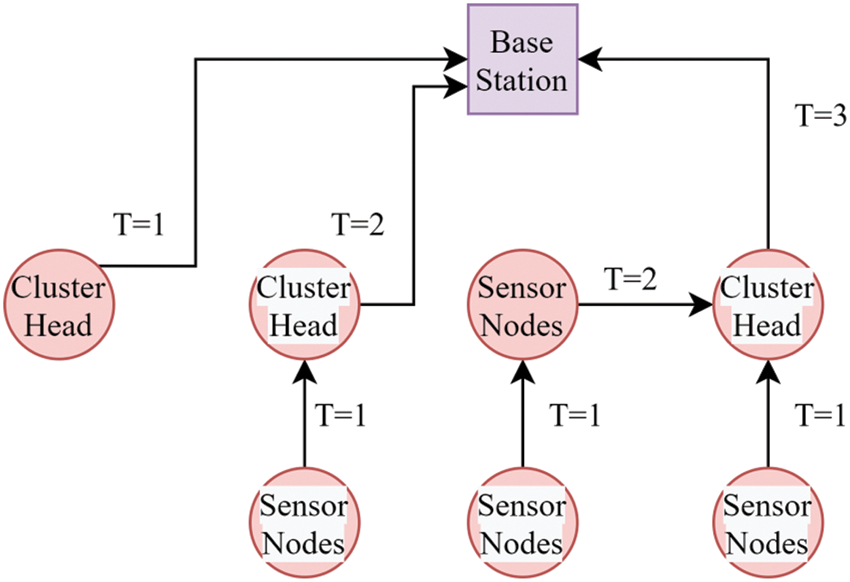
Figure 2: Scheduling with nodes
These constructions and scheduling of the network are the two components of our approach to the aggregation problem. One or more data aggregation trees are constructed during the network development phase. Each tree is constructed according to the least delayed tree built outlined in the previous section.
SN is organized to send data in the planning stage following the creation of the network structure. Each node has a time window to aggregate and transfers data to its parent. In a single period, communication is expected. Only one packet per time slot can receive a node.
During the construction phase, two clusters of the same size are combined into a larger cluster to obtain the least feasible delay structure. This operation is repeated until clusters can no longer join other clusters of the same size and connect directly to the BS. Established on this method, the ultimate architecture of the network will comprise cluster sizes.
The scheduling procedure is easy to understand. The position of all nodes in the network’s topology dictates its period. Each parent node’s child has a different rank corresponding to varying transmission times. As a result, it is not feasible to receive numerous parent nodes. As each cluster is distinct in size, the CHs are sorted differently. As a result, data packets are sent by these CHs to the BS at different times. Fig. 3 shows the model of our network arrangement and timetable.
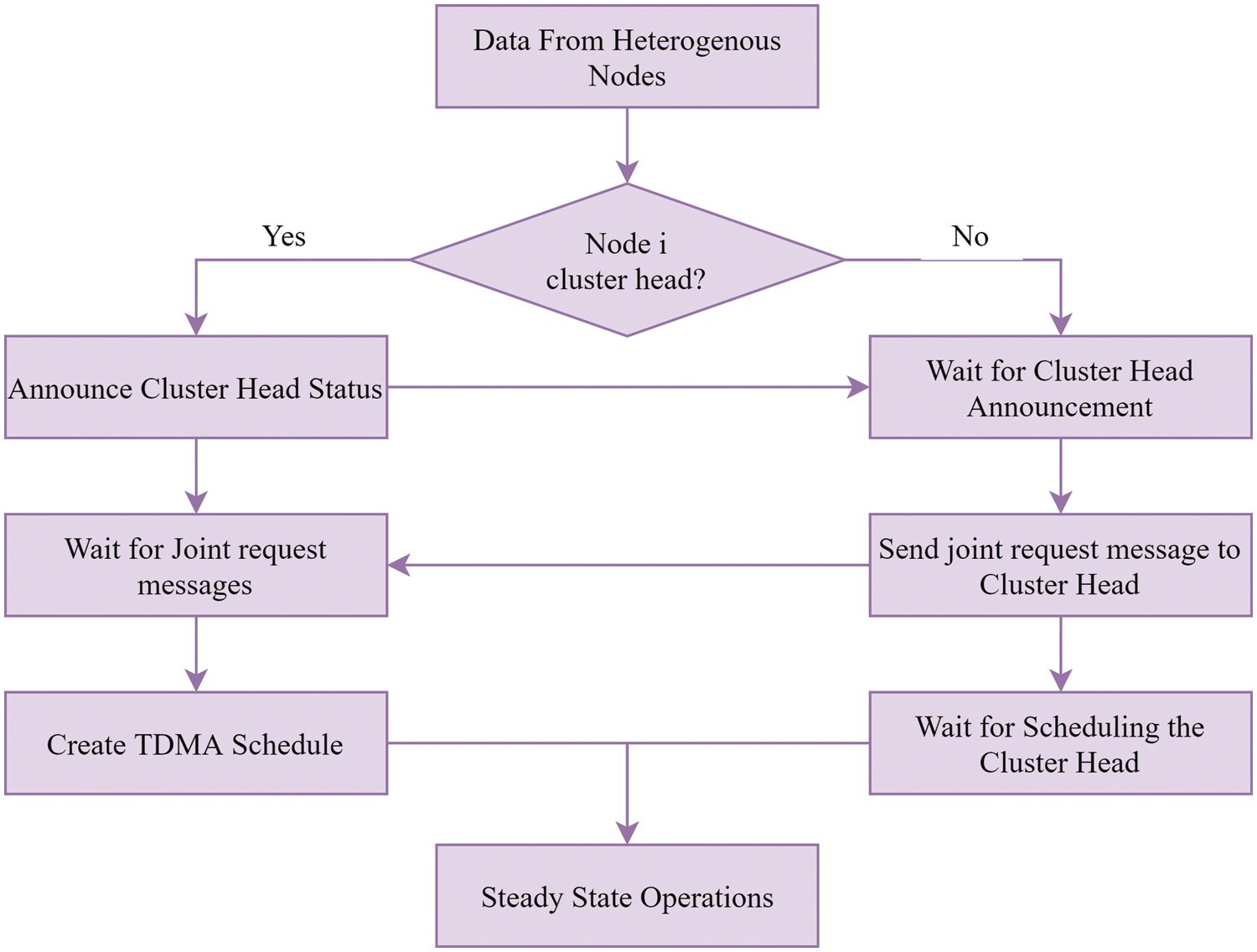
Figure 3: Hetero-LEACH flow chart
Each cluster communicates with a Direct Spread Spectrum Sequence (DSSS) to reduce interference. Every cluster routine a single sequence of distribution code, and every cluster nodes use that code to interconnect. Clustering is optimal because energy depletion is well scattered across all sensor nodes, with minimal energy depletion. Suppose that N nodes in the region of (M × M). Here will be k clusters with a Cluster head and (N/k)-1 non-CH nodes.

3.5 Whale Optimization Algorithm
A new data storage WOA is presented using QoS limitations, and the WOA is easy to compute. WOA does a first phase global search, but the second phase local searches can produce a routing path that complies with QoS standards. WOA has a stronger capacity for a local search than other heuristic algorithms. Adverse: It’s easy to reach the optimal local condition. The clone operator can succeed in preventing the development of optimal local conditions. The WOA has a faster convergence rate, making it more viable. As a result, WOA is based on WOA but much more rapidly and optimally. WOA provides the ideal routing path with minor energy use, extends the life of WSN’s network, and reduces plant costs. In addition, unlike normal WOA, clone and adaptive operators are available to WOA. The flow chart of the Whale optimization algorithm is described in Fig. 4.

Figure 4: Whale optimization algorithm flow chart
Encoding is the initial step in applying WOA to optimize WSN’s energy consumption routing issue. The specified objective is difficult to fulfill with standard decimal coding, and the optimum routing is to use less energy under QoS restrictions. Binary encoding allows easy encoding and decoding. When binary encoding, 1 indicates that the node passes and 0 indicate that it does not pass. The first and last bits are 1 as the source, and destination nodes must be passed. The third and fourth bits are 1, shown by the first, third, fourth and fifth nodes.
B is the whale location of b, while G, r is the coefficient random vectors
The position of the whale cannot be modified with the position of the leading whale to prevent optimum placement. The problem of optimization routing can be solved under cost constraints and must be regularly updated with the partners’ positions. The spiral updating phase relates to the exploitation phase, which mimics the shape and movements of whales as follows:
where cos is the random location where whale tends to move for searching the prey. The WOA will in particular do a random search at this point and get the succeeding station of the whale under the impact of the coefficient.
The following steps can be explained as.
Step 1. Determines the number of sensors and population sizes, creates sensor nodes at random within the monitoring zone and produces whale positions at random. Set the parameters for the first iteration.
Step 2. Compare, identify, and define the lead whale by equation and compare them with their fitness.
Step 3. Enter the main algorithm loop if each whale updates its position, else it will update its position.
Step 4. Update the coefficient of vectors and equations
Step 5. Estimate and classify the fitness of the whaling population by method 1, followed by a high probability mutation for a cloned population.
Step 6. Analyze the fitness equation significance for global value
The performance parameters for data aggregation are listed below:
In an ideal world, each sensor would require an identical quantity of energy throughout each data collection phase, but sensor nodes would need various amounts of power for communication in practice. A data aggregation technology that is energy efficient in WSNs offers optimum functionality while using the lowest amount of power. The proportion of the amount of data positively communicated in a sensor network to the total energy consumed to convey these data is known as energy efficiency. The energy efficiency of a structure is determined by:
The network lifespan is the number of data aggregation cycles completed before the first sensor node runs out of power. In other words, it’s time to run out of energy (battery power) or disconnect the network from the system’s first sensor node (or collection of sensor nodes) due to one or more sensor failures.
The network lifespan ends when the first node fails, where NLv is the lifetime of node v and V is the node-set excluding the sink node.
The application for which the sensor network is designed is frequently indicated. For example, in the target location problem, the data correctness is determined by closely analyzing the target location on the sink. The data transfer ratio to the total data transferred is used to define data accuracy:
The period between data creation at the foundation nodes and the access of data packets at the sink is known as latency. The latency is the time it takes for a sensor node to deliver and receive data. The following equation was used for latency calculation:
Data aggregation is the process of gathering data and presenting it in a summarized manner. The information might originate from several places to combine into a single summary for examination.
Data Aggregation Rate = (Amount of data aggregated successfully/Total amount of data sensed) × 100
4.1 Data Aggregation Model Using Hetero-LEACH
Each cluster communicates with a direct spread spectrum sequence to reduce interference. Every cluster routine a single sequence of distribution code and every cluster node use that code to interconnect. Clustering is optimal because energy depletion is well scattered across all sensor nodes, with minimal energy depletion. Suppose that N nodes in the region of (M × M). Here will be k clusters with a Cluster head and (N/k)-1 non-CH nodes.
We applied some data aggregation Models after calculating the lowest possible optimal energy and Whale optimization to reduce delay and energy consumption further. In the beginning, we used the Hetero-LEACH Algorithm. Each feature of H-LEACH has been presented, and selected parameters can be seen as Dimensions are selected as x and y see Table 1. While sink nodes are 0.5, 0.5 at x and y. The optimal Probability of Nodes is 0.2. There is 10% heterogeneity in the sensor nodes, and the maximum rounds in which the nodes can transfer the data are 7000. Experimental setups are performed in the MATLAB simulator, and all measurements/graphs have been extracted with QoS focal parameters.

There are two sorts of nodes, each with a distinct energy level. Normal nodes are represented by the letter ‘o,’ advanced nodes by the letter ‘+,’ and base stations by the letter ‘x’. The cluster formation in which cluster heads are represented by ‘*’ is shown in Fig. 5.

Figure 5: Heterogeneous LEACH protocol test network
There are two sorts of nodes, each with a distinct energy level. Normal nodes are represented by the letter ‘o,’ advanced nodes by the letter ‘+,’ and base stations by the letter ‘x’. The cluster formation in which cluster heads are represented by ‘*’ is shown in Fig. 5.
The number of alive nodes and dead nodes, see Fig. 6, illustrates a total 2300 of rounds, dead nodes are at a maximum level. While at the 1200th round, the stability period of the wireless system declined.
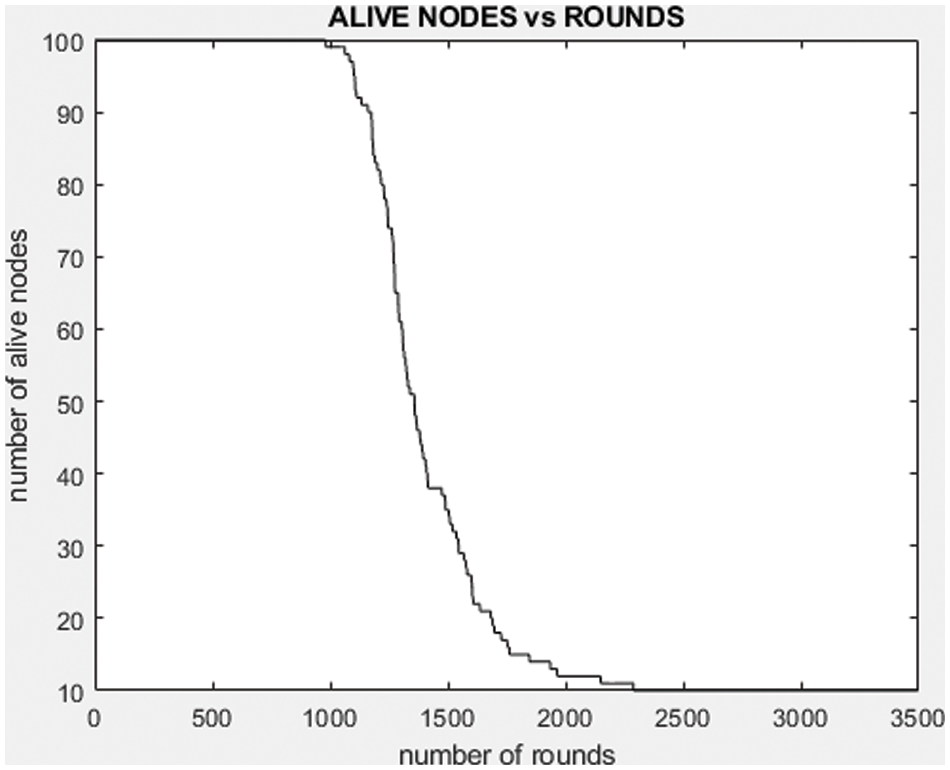
Figure 6: Performance of H-LEACH algorithm
Fig. 7 shows the performance of H-LEACH in terms of dead nodes, maximum values of dead nodes can be seen at the 2500th round. While at the 1200th round, the stability period of the wireless system declined.
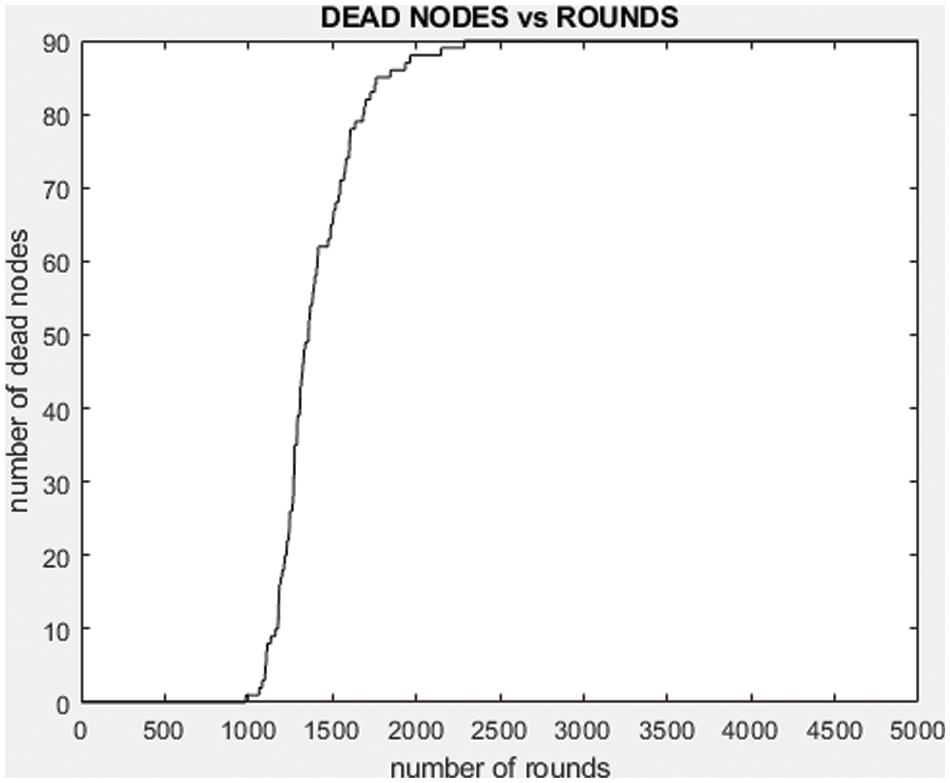
Figure 7: Performance of H-LEACH algorithm for number of dead nodes
As shown in Table 2, H-LEACH performs 2300 rounds and the first dead node after 2300 rounds. All remaining parameters’ stability period and energy remaining are maximum. While in other techniques, results showed less performance and a low stability period. Simulation is performed on all techniques with the same parameters in MATLAB.

4.2 Whale Optimization Algorithm
The WOA was naturally motivated, and this technique’s ability to solve several issues has been shown. Other algorithms inspired by nature, such as Artificial Bee Colony (ABC) and Particle Swarm Optimization (PSO), have also been widely researched. Nevertheless, no WOA survey study has been conducted. We applied WOA on H-LEACH to further improve the energy delay and reduction. The parametric space of WOA is being shown, see Fig. 8.
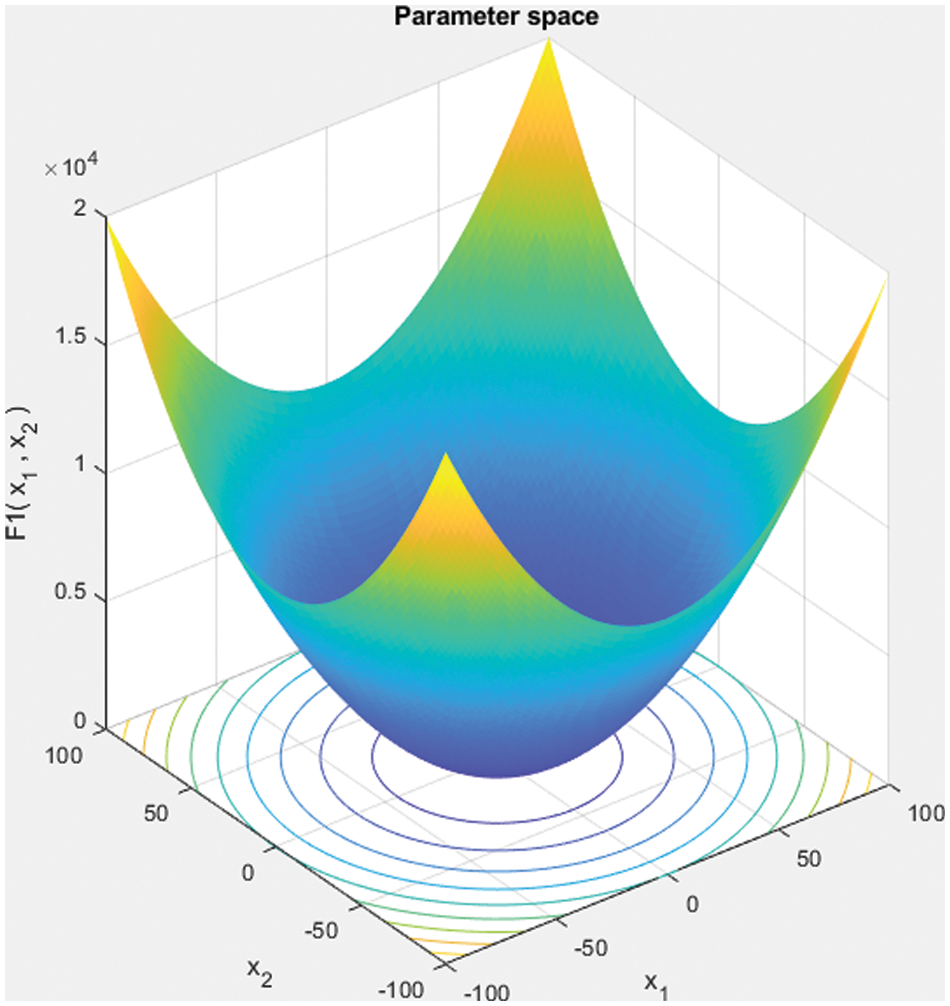
Figure 8: Parametric space of WOA
Table 3 shows the simulation results of H-LEACH and then improvised results with the whale optimization technique. In the H-LEACH, the death of the first node is after 2300 rounds, while with optimization, it reaches 3000 rounds. And stability time is 1152 sec, while with optimization, it also increases. The overall performance of quality of service is enhanced with a WOA optimizer. The lifetimes of the nodes are enhanced. The objective space of the whale optimization algorithm is described in Fig. 9.


Figure 9: Iterative objective space of whale optimization algorithm
In a multi-objective algorithm like WOA, the fitness function and objective functions have been created before the algorithm runs. The fitness function tends to fit the system to improve the cost.
In this work, we used a hybrid approach, combining different data aggregation techniques and WOA. Our proposed process consists of two major phases: one is data aggregation, and the second is an optimizer for energy and delay reduction, which increases the performance of wireless networks. In phase one, data aggregators like H-LEACH, LEACH, SEP, PEGASIS, and MAMC are used to perform data aggregation. Whale Optimization Algorithm used for increasing lifetime with H-LEACH, by this computational complexity has been reduced. Results show that our proposed hybrid model has more efficient than previous models because there is no implementation with the optimization algorithm we used in this work.
In future directions, a more efficient energy model with high batteries in sensor nodes is required to reduce the tradeoff issues and provide a cost-effective solution. Applications in wireless sensor networks are enhanced from time to time. QoS metrics need to enumerate in a single model which will cover all parameters. Moreover, QoS metrics can be enhanced by improving the security mechanism and providing some rules to select the best path over the communication.
Funding Statement: The authors are thankful to the Deanship of Scientific Research at Najran University for funding this work under the Research Collaboration Funding program Grant Code NU/RC/SERC/11/7.
Conflicts of Interest: The authors declared that they have no conflicts of interest to report regarding the present study.
References
1. D. Kim, J. Yun and D. Kim, “An energy-efficient secure forwarding scheme for qos guarantee in wireless sensor networks,” Electronics, vol. 9, no. 9, pp. 1–15, 2020. [Google Scholar]
2. S. Ozdemir and Y. Xiao, “Secure data aggregation in wireless sensor networks: A comprehensive overview,” Computer Networks, vol. 53, no. 12, pp. 2022–2037, 2009. [Google Scholar]
3. A. Kaur and S. Vatta, “Implementation of LEACH, hetero-LEACH, SEP and EEHC protocols using MATLAB in wireless sensor network,” International Journal of Engineering Research & Technology, vol. V5, no. 4, pp. 594–601, 2016. [Google Scholar]
4. S. Faisal, N. Javaid, A. Javaid, M. A. Khan, S. H. Bouk et al., “Z-SEP: Zonal-stable election protocol for wireless sensor networks,” Journal of Basic and Applied Scientific Research, vol. abs/1303.5364, pp. 1–9, 2013. [Google Scholar]
5. S. Selvakumar and S. Swamynathan, “Cluster-chain mobile agent routing algorithm for efficient data aggregation in wireless sensor network,” Journal of Communications and Networks, vol. 19, no. 4, pp. 392–401, 2017. [Google Scholar]
6. A. Naureen and N. Zhang, “A comparative study of data aggregation approaches for wireless sensor networks,” in Q2SWinet 2016-Proc. 12th ACM Symp. QoS Secur. Wireless Mobile Networks, co-Located with MSWiM, Malta, Malta, pp. 125–128, 2016. [Google Scholar]
7. N. Rana, M. S. A. Latiff, S. M. Abdulhamid and H. Chiroma, “Whale optimization algorithm: A systematic review of contemporary applications, modifications and developments,” Neural Computing and Applications, vol. 32, no. 20, pp. 16245–16277, 2020. [Google Scholar]
8. N. Moussa, Z. Hamidi-Alaoui and A. E. B. El-Alaoui, “EHRP : An effective hybrid routing protocol to compromise between energy consumption and delay in WSNs,” International Journal of Electrical and Computer Engineering, vol. 10, no. 5, pp. 5462–5469, 2020. [Google Scholar]
9. I. Daanoune, A. Baghdad and A. Ballouk, “An enhanced energy-efficient routing protocol for wireless sensor network,” International Journal Electrical Computer Engineering, vol. 10, no. 5, pp. 5462–5469, 2020. [Google Scholar]
10. S. Bhushan, M. Kumar, P. Kumar, T. Stephan, A. Shankar et al., “FAJIT: A fuzzy-based data aggregation technique for energy efficiency in wireless sensor network,” Complex Intelligent Systems, vol. 7, no. 2, pp. 997–1007, 2021. [Google Scholar]
11. A. Kaveh and M. I. Ghazaan, “Enhanced whale optimization algorithm for sizing optimization of skeletal structures,” Mechanics Based Design of Structures and Machines, vol. 45, no. 3, pp. 345–362, 2017. [Google Scholar]
12. J. Bhola, S. Soni and G. K. Cheema, “Genetic algorithm based optimized leach protocol for energy efficient wireless sensor networks,” Journal of Ambient Intelligence and Humanized Computing, vol. 11, no. 3, pp. 1281–1288, 2020. [Google Scholar]
13. M. B. Shyjith, C. P. Maheswaran and V. K. Reshma, “Optimized and dynamic selection of cluster head using energy efficient routing protocol in WSN,” Wireless Personal Communications, vol. 116, no. 1, pp. 577–599, 2021. [Google Scholar]
14. T. AL-Khdour and U. Baroudi, “A generalised energy-efficient time-based communication protocol for wireless sensor networks,” International Journal of Internet Protocol Technology, vol. 4, no. 2, pp. 134–146, 2009. [Google Scholar]
15. X. Li, W. Liu, M. Xie, A. Liu, M. Zhao et al., “Differentiated data aggregation routing scheme for energy conserving and delay sensitive wireless sensor networks,” Sensors (Switzerland), vol. 18, no. 7, pp. 1–29, 2018. [Google Scholar]
16. S. M. Kashif, M. Hassan, K. Mahmood, A. M. Shah and J. Khan, “Efficient solution for connectivity restoration (ESCR) in wireless sensor and actor-networks,” Wireless Personal Communications, vol. 117, no. 3, pp. 2115–2134, 2021. [Google Scholar]
17. M. Wu, Y. Wu, C. Liu, Z. Cai, N. N. Xiong et al., “An effective delay reduction approach through a portion of nodes with a larger duty cycle for industrial WSNs,” Sensors (Switzerland), vol. 18, no. 5, pp. 1–28, 2018. [Google Scholar]
18. I. Mosavvar and A. Ghaffari, “Data aggregation in wireless sensor networks using firefly algorithm,” Wireless Personal Communications, vol. 104, no. 1, pp. 307–324, 2019. [Google Scholar]
19. T. K. Dao, J. Yu, T. T. Nguyen and T. G. Ngo, “A hybrid improved MVO and FNN for identifying collected data failure in cluster heads in WSN,” IEEE Access, vol. 8, no. 1, pp. 124311–124322, 2020. [Google Scholar]
Cite This Article
 Copyright © 2023 The Author(s). Published by Tech Science Press.
Copyright © 2023 The Author(s). Published by Tech Science Press.This work is licensed under a Creative Commons Attribution 4.0 International License , which permits unrestricted use, distribution, and reproduction in any medium, provided the original work is properly cited.


 Submit a Paper
Submit a Paper Propose a Special lssue
Propose a Special lssue View Full Text
View Full Text Download PDF
Download PDF Downloads
Downloads
 Citation Tools
Citation Tools